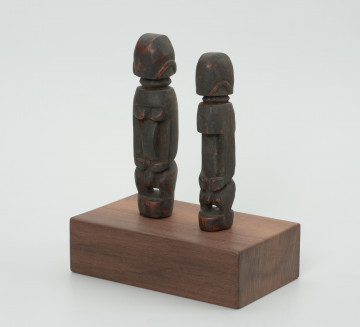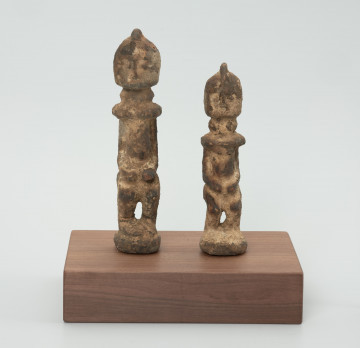
Divination set
między 1951 — 2000
National Museum in Szczecin
Part of the collection: Collection of Dogonian art
The divination set presented here consists of four anthropomorphic figures, representing two men and two women, and two zoomorphic figures, most likely a crocodile and a fox, animals of particular importance in Dogon mythology. The crocodile (Osteolaemus tetraspis) - ayo geu, commonly called caiman, is considered a sacred and protective animal that brings regular rains and ensures farmers a bountiful harvest, while the image of the mythical pale fox (Vulpes pallidus), called Yurugu by the Dogon, is a deity created by the creator god Amma. According to Dogon mythology, Yurugu brought chaos and unrest to the world created by Amma, as he committed an incestuous act by entering into a relationship with his mother Earth. As a result of this act of disobedience towards his creator, he lost the ability to speak, as Amma punished him by cutting off his tongue (that is why real foxes emit only a short, almost broken scream). However, he gained the power of foretelling the future, which fortune-tellers read from the traces of his paws.The Dogon know many methods of divination, but the most popular is divination from the traces of the fox, which is carried out by diviners called yurugu yaine or yurugu kunugu. The essential attribute of a fortune teller is a fortune board, which he draws on a flat area outside the village. After drawing all the lines and arranging the symbols, he places bait in the form of peanuts on the board to encourage the yurugu to 'speak'. The fox comes at night and its footprints trampled on the sand scattered on the rectangular fields of the board form the answer to the question asked.
Katarzyna Findlik-Gawron
Author / creator
Dimensions
cały obiekt: height: 19,2 cm, width: 13,5 cm
Object type
sculpture
Creation time / dating
Creation / finding place
Identification number
Location / status

między 1951 — 2000
National Museum in Szczecin

między 1951 — 2000
National Museum in Szczecin

między 1951 — 2000
National Museum in Szczecin
DISCOVER this TOPIC
National Museum in Lublin
DISCOVER this PATH
Educational path